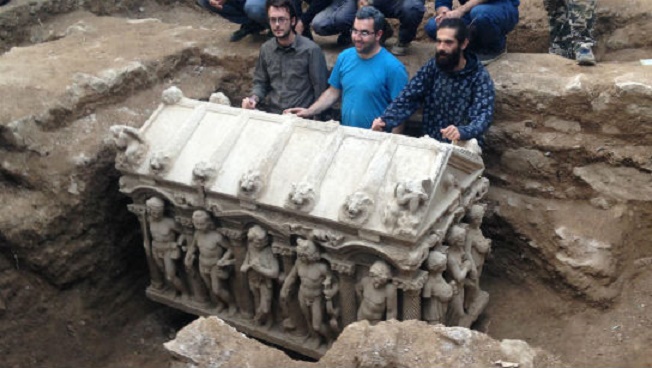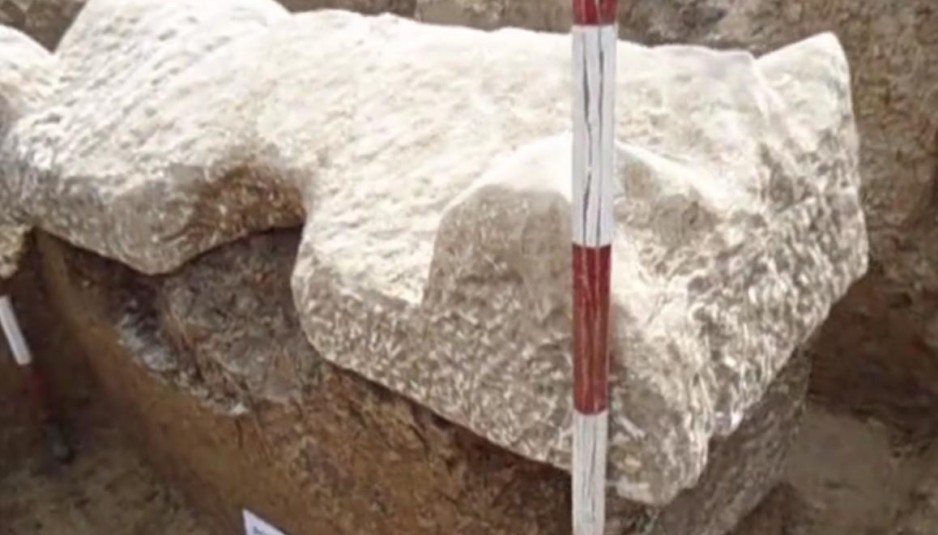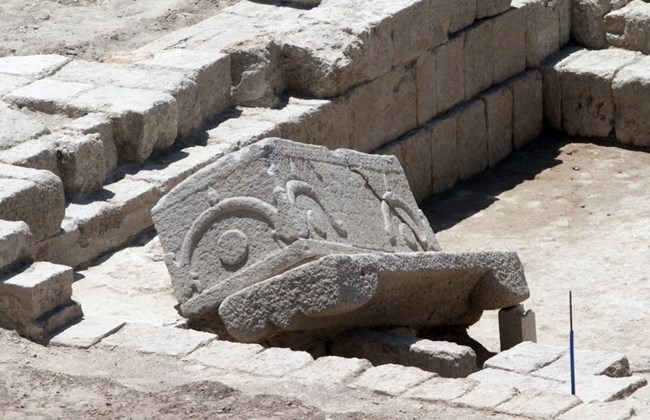|
As just reported by the BBC, a Roman sarcophagus was uncovered last month at a construction site on Swan Street, near Borough Market, in central London. It was found within a fourth-century mausoleum occupying prime real estate: directly beside the main road into the city, always the most desirable location in any Roman town's funerary landscape. The sarcophagus itself — only the second such ever discovered in London — has not yet been fully freed from the dirt, so its decoration is yet unknown. Initial tests with a metal detector, however, indicate the presence of small metal objects within, raising hopes that some grave goods may have survived. As reported by The Daily Mail, The BBC, The Telegraph, and The New York Times, among others, a Roman sarcophagus (or at least, the front slab of one) has been discovered on the grounds of Blenheim Palace, where it has spent the last century in service as a tulip planter. This lenoid piece (a coffin shaped like a lenos: a wine vat) features the lions-head bosses typical for this shape, while the figural frieze itself — a Dionysiac scene of the inebriated god approaching the sleeping form of his beloved Ariadne, her own pose echoed by that of Hercules reclining boozily at left (an unusual addition) — plays on the lenos's associations with wine. The dates reported for the piece are a mess. Most of the sources above describe it as "dating back to A.D. 300" or "300 AD" — but then go on to quote spokesmen who place the carving in the 2nd century (i.e., well over a century earlier), with no notice of the resulting chronological inconsistency. In truth, neither set of reported dates can be correct. AD 300 is far too late for this work. But the 2nd century is just as clearly too early, as an eye to the carving technique reveals. (Just look at the drill-heavy treatment of the lions' manes.) A 3rd-century date, tilting earlier rather than later — the 220s AD, or perhaps even the 230s — seems most likely. Istanbul's Daily Sabah reports that yet another Roman sarcophagus has been discovered in Turkey's Hisardere district, five kilometers northeast of İznik, less than a year after the discovery of this piece in the same district.
The İznik Museum, it is related, plans to put the specimen on display. At least three sarcophagi — one Roman specimen, joined by two Etruscan terracotta pieces featuring kline portraits — were among thousands of archaeological artifacts recently repatriated to Rome from Geneva's Freeport warehouse complex, as reported by the Guardian. Uncovered by a sting operation in 2014, the artifacts, filling 45 crates and reportedly worth some 9 million Euros (although one wonders on what the valuation is based...), where retrieved from the storage unit of Robin Symes, a notorious dealer in illegal antiquities who smuggled the objects, stolen from south Italian digs in the 1970s and 1980s, into Geneva decades ago. As originally reported by Today's Zaman (no longer available) and reposted by News Network: Archaeology: in November of last year a Roman sarcophagus was unearthed by a farmer in the Hisardere area of Turkey, northeast of İznik.
The format of the coffin seems typical of those from Docimium/Dokimeion; but Esen Öğüş, a colleague more familiar with eastern sarcophagi than I, tells me she thinks it is actually a local product carved in imitation of the expensive Docimean pieces. She intends to publish the finding. As reported by the Tribune de Genève — and later covered in greater detail by the Tages-Anzeiger (many thanks to Christian Russenberger for the link) — a Swiss public prosecutor has ordered that a Roman sarcophagus deposited in the Geneva Freeport warehouse in 2010 and subsequently seized by Swiss Customs during an inventory check later that year be returned to Turkey. The piece itself is exquisite: a creamy Docimean specimen, likely Antonine in date, showing the Twelve Labors of Hercules. As detailed in earlier blog posts (here, here, and here), Metropolitan sarcophagi (i.e., those from the city of Rome itself) devoted to the Labors of Hercules typically array the hero's first ten labors on the front of the chest in narrative order, with the eleventh and twelfth depicted on the short ends, and nothing on the back (as usual for Metropolitan works), This piece, in contrast, strews the vignettes around all four sides — as expected for an eastern product — in no discernable order. Israel's Haaretz reports the discovery of a Roman sarcophagus at Ashkelon by building contractors who, fearing delays in their construction of luxury villas if its existence were reported to the authorities, instead decided to conceal it. Using a tractor to pull it from the ground — in the process scarring the stone and damaging the relief on multiple sides — they then poured a concrete floor over the findspot to efface any signs of excavation, and hid the sarcophagus beneath a stack of boards and sheet metal. (Additional details here and here.) With a length of 2.5 meters (8.2 feet), this is a massive piece. The lid features a portrait of the deceased shown reclining: not in itself unusual, were it not for the hollow eyes, clearly originally inlaid. This, several other decorative idiosyncrasies, and the fact that the coffin is carved from limestone rather than marble all point to a local product. Romania's Nine O'Clock reports the discovery — the first ever — of a Roman sarcophagus at ancient Porolissum, capital of Dacia Porolissensis.
The limestone chest and lid apparently lack adornment and are clearly unfinished. Judging from the lid's four corner acroterial projections and its double-pitched roof, however, the carver was following eastern rather than metropolitan Roman models. This choice might seem a bit unexpected for a Latin-speaking province — but is perhaps less surprising in light of Porolissensis's Transylvanian location and proximity to eastern centers. The large notch cut in the lid, showing signs of discoloration, is intriguing. Perhaps a sign of reuse? Reuse might also account for the coffin's unusual find spot: not in the town's necropolis outside the Roman castrum, but rather "within the sacred area". (of Liber Pater? of Nemesis? We're not told.) Lebanon's Daily Star reports the excavation of a Roman sarcophagus, as well as remnants of an ancient well, at a construction site in Sidon's Bustan al-Kabir neighborhood. From the photograph below the sarcophagus appears to be of standard eastern garland type, pressed into service as a blank.
Two burial grounds, yielding skeletons, pottery, and coins with Latin inscriptions, were found at the same site a month ago. The relationship of the sarcophagus and the burials to the well has not yet been clarified. Istanbul's BGN News reports that Turkish authorities near Izmir recently foiled an attempt by two men to smuggle a Roman child's sarcophagus out of the country in a light commercial vehicle. According to the report, official analysis of the recovered sarcophagus revealed that it had never before been opened. (So what were the contents when the piece was finally uncorked? — we're not told.) It was subsequently delivered to the Directorate of the Izmir Museums. The fuller story is here. That the specimen — from the pictures, a wee piece featuring garlands suspended from rams' heads — is "at least 2,000 years old" seems unlikely. |
Roman
|





